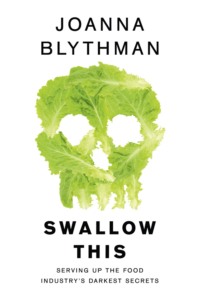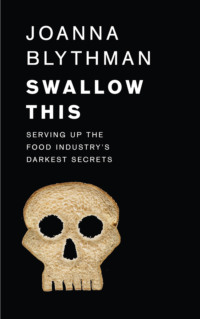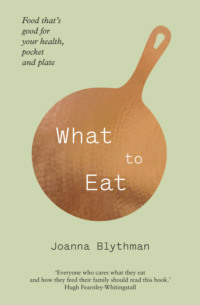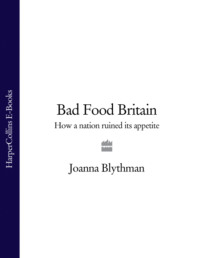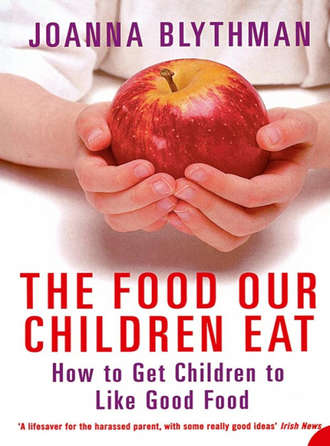
Полная версия
The Food Our Children Eat: How to Get Children to Like Good Food
The motivation is not just the well-being of our children but the satisfaction that we parents can get from knowing that our children share with us a love of food and the pleasure of eating. When we are older and greyer, what a delight to drop in to a son or daughter for a home-cooked meal prepared from fresh, wholesome, unprocessed ingredients. And if there are grandchildren sitting around the table, too, all the better. If they learn, as their parents did, to appreciate real food, then our food chain will be so much safer in their hands.
THE MODERN ‘CHILDREN’S DIET’
Let’s look at those distinctive foods that have become the mainstay of the modern British children’s diet. It won’t take long, because they are so very limited.
The backbone foods and drinks of the very restricted diet and their shortcomings
BREAKFAST CEREAL AND MILK
The typical ‘children’s cereal’ favourites consist of highly processed and over-refined grains stuck together with sugar in one form or another, and many are also high in salt. Prominent added vitamins give an aura of health but are only an attempt to replace the goodness that has been refined out of the processed grain. These are overwhelmingly sugary foods. The nutritional goodness of the milk (protein, calcium and vitamins) can’t compensate for that.
BURGERS
Mass-produced burgers of the type aimed at children have a very different composition from ones you might make at home. They tend to contain much more fat, and include a number of chemical additives to improve flavour and consistency. They are generally made with meat that represents the lowest common legal denominator in terms of cuts allowed and the source of the animals.
SAUSAGES AND SAUSAGE ROLLS
Similar objections to burgers except that the amount of meat is often lower and there are more chemical additives. Sausage rolls have an additional layer of fatty pastry which makes them even less healthy. They are often served inadequately reheated from frozen and this, combined with the poor quality of the meat, makes them a likely food poisoning source.
POULTRY OR FISH IN BREADCRUMBS
Any food in breadcrumbs is automatically much fattier than its unbreaded equivalent because the coating holds fat, even when it is grilled rather than fried. Apart from whole fillets of poultry or fish, the minced poultry meat in products such as Kievs and nuggets represents a very low-grade mulch of intensively produced meat, held together with chemical additives. They seem cheap but they represent poor value for money given the ingredients used.
FISH FINGERS
Many contain just a fish and additive sludge. Some more expensive fish fingers do contain only fish fillets – even if this is at a vastly inflated price – but they are a less healthy alternative to a plain fillet because of the coating.
CHIPS
A very fatty food, even oven or lower-fat chips. Processing can result in a loss of vitamins.
TINNED BAKED BEANS
Beans offer useful fibre, some protein and beneficial vitamins. But tinned versions usually contain surprisingly large amounts of sugar and salt. This makes them less healthy than we might think.
TINNED TOMATO SOUP
The healthy nutrition offered by the tomatoes is outweighed, or at least cancelled out, by the unhealthy amounts of sugar. Another ‘savoury’ food that is usually surprisingly sweet.
PIZZA
A disc of highly refined bread dough with a very thin smear of sweetened tomato concentrate and some rubbery processed cheese, most kid’s pizzas are temporarily filling but low on any positively beneficial ingredients.
SWEETS
Children’s chocolate confectionery is basically a mixture of chemically hardened vegetable fats, vast amounts of sugar and small amounts of cocoa solids, with chemical flavourings. Fruity sweets consist mainly of sugar, mixed with sometimes natural but mainly chemical flavourings, colourings and other additives.
BISCUITS
Typical children’s biscuits consist overwhelmingly of highly refined flour, generous quantities of sugar and chemically hardened vegetable fat. Healthier-seeming versions prominently featuring ingredients such as oats and dried fruits often contain even more sugar than the standard biscuit and surprisingly large amounts of fat.
CRISPS AND EXTRUDED SNACKS
Crisps are both fatty and high in salt. Flavoured ones nearly always contain chemical additives and sweeteners in various forms, too. They are not filling and offer little good nutrition, so they will leave a hungry child dissatisfied and most probably thirsty, too.
Extruded snacks come in shapes such as hoops, flying saucers or wafers, not slices. They are called extruded because they are made from a mixture of dehydrated potato, starches, emulsifiers and a number of chemical additives which is forced out (extruded) in a particular shape. They tend to contain even more additives than crisps.
FIZZY DRINKS
These are basically water that has been carbonated and then flavoured with artificial – or occasionally natural – flavourings. They also contain other chemical additives such as colourings and huge amounts of sugar or smaller amounts of chemical sweeteners. The routine presence of certain chemical preservatives and flavourings is now being linked to allergic reactions of all sorts, but particularly oral disease causing puffy lips, mouths and swollen jaws. These drinks contain nothing that is beneficial for health; instead they include ingredients that are known to attack good health. A typical can of cola contains the equivalent of seven teaspoons of white sugar. Drinks with sweeteners may have fewer calories and won’t attack tooth enamel but some scientists believe sweeteners may pose a risk to health.
SQUASH
Squash in its many forms often presents a healthy image based around the goodness of fruit. Some do contain real fruit juice in very small quantities but otherwise their ingredients are similar to fizzy drinks, just without the carbon dioxide, and the same objections apply. Even when considerably diluted, they can acustom children to a level of sweetness that makes ‘real’ drinks seem unpalatable by comparison.
ICE CREAM
The more expensive ‘premium’ ice creams contain a lot of fat in the form of cream and a lot of sugar but there is some nutritional goodness to be had from the non-sugar ingredients and they are fairly naturally made. Cheaper ice creams aimed at children, however, are highly synthetic concoctions of air, water, milk powder, hardened vegetable fat and lots of sugar blended together with chemical emulsifiers, stabilisers, colourings and flavourings.
The slightly wider range of popular children’s foods and their limitations
APPLES AND BANANAS
These are really nutritious foods and it is good that children eat them but they are the only fruits that many children eat. If they are given them all the time, they may get bored with them and decide they don’t like fruit in general.
FROZEN PEAS AND SWEETCORN
Frozen vegetables are a useful and nutritious stand-by. But peas and sweetcorn both taste quite sweet. Children need to get used to a range of vegetables with different flavours, such as the tartness of a fresh tomato, the refreshing quality of cucumber and the pepperiness of watercress.
TOAST
Toast is only as good as the quality of the basic bread and what you put on it. Most mass-produced British bread is pappy, light and insubstantial. It takes many slices of this sort of bread to fill you up because it fails to satisfy. Children may be spreading fats or jams on each slice, so when several slices are being eaten, the fats and sugars in the spreads can easily dwarf any goodness to be had from the bread.
YOGURT AND FROM AGE FRAIS
A straightforward natural yogurt or fromage frais, flavoured with fruit purée, is a healthy and nutritious food but most children’s versions have so much sugar or artificial sweetener in them that they need to be thought of as puddings. A thick fruit compote layer can be surprisingly sweet, and it’s now common for crunchy, sweet additions to be sold as part of a yogurt or fromage frais dessert. Cheaper types often contain no fruit, just chemical fruit flavours. Some that do contain fresh fruit routinely include chemical preservatives, which are not beneficial for health (see page 120).
If we let children eat almost exclusively from this typical range of children’s food, what does their diet amount to? We can sum it up as consisting overwhelmingly of processed foods composed of:
• lots of protein
• lots of refined carbohydrate or starchy food
• lots of fat, sugar and salt.
Fruit and vegetables are almost entirely missing or under-represented.
This is more or less the opposite of what children should be eating for good health. Though there is still surprisingly little consensus on what constitutes a ‘healthy’ diet, most nutritionists would agree from various perspectives that this classic children’s diet is a disaster.
With its almost total absence of fruit and vegetables – the key category of food that all nutritionists think is healthy – and its heavy reliance on refined carbohydrate, sugar and fat, not to mention the excessive amounts of protein, the typical children’s diet seems to be incompatible with long-term good health.
This modern form of malnutrition, learned in childhood and very likely carried on into adulthood, is clearly implicated heavily in the growing prevalence of obesity. It is also increasingly viewed as a strong contributory factor in a surprisingly wide range of illnesses, from heart disease to cancer. If our children continue to eat this way, the prognosis for the nation’s health looks very gloomy.
For parents who feel they can’t live with that thought, Parts Two to Four of this book concentrate on practical ways to break out of the children’s junk-food ghetto. Healthier Look-alike Alternatives to Common ‘Children’s Foods’ (pages 114–19) points you in the direction of foods that have the appeal of junk for children but are healthier and more natural.
‘PICKY-EATER’ CULTURE
These days, more adults than ever before seem to have inordinate difficulty getting their children to eat a reasonably wide range of good, wholesome food. Why do we live in a land where children seem drawn only to food that is bad for them?
It’s a curious modern phenomenon. British and American children seem to be bonded by a common culture that fosters resistance to good food. They stand out from children in other parts of the world with more traditional food cultures, even Europe. Most Italians would throw up their hands in horror at the very idea of a child who would not eat vegetables. In the UK we shrug our shoulders and say, reluctantly, that this is normal. In France, sales of crisps rely on adults serving them with drinks as an aperitif. It would be an eye-opener to most French people to witness the hordes of U K schoolchildren walking to and from school with bags of crisps and fizzy drinks. In fact it seems that wherever Anglo-American food culture becomes strong, a liking for junk food and a problematic attitude towards good food follow. Within this type of food culture there has been a population explosion of ‘picky eaters’. When once the infamous picky eaters were the exception, now they are the rule.
How can this be? There are lots of theories ploughing both sides of the nature-nurture divide. One belief is that junk food is basically so appealing that once children have tasted it that is all they will want: it is just a matter of time until those other traditional food countries follow suit.
Listen to the powerful transnational companies that run the food industry and you might believe that it had absolutely nothing to do with creating those modern legions of picky eaters. They say that they are simply servicing a need for popular food. If children are eating badly, then that is their parents’ fault for not balancing their diet. There is no such thing as an unhealthy food, they tell us, just an unhealthy diet.
Working mothers are another ‘usual suspect’, often asked to carry the can for children’s deteriorating food habits. We are told that because women now work (in three out of every five families where the parents are married, women have jobs), this has led to the erosion of family meals and real food in favour of more convenient processed food. So grazing has taken over from three square meals, leading to ever more reliance on anything that is quick to prepare and comes in single units of food that can be eaten as required. Junk food fits the bill.
All these theories are basically fatalistic about children’s susceptibility to junk and treat it as a fact of modern life – no turning the clock back. When forced to face up to the consequences of this thinking in the form of the millions of children who now fit the picky-eater description, there is a general wringing of hands. Helpful responses come in the form of quick techno-fixes. Okay, your children don’t want to eat breakfast, so we have created breakfast bars. The fact that they are stuck together with sugar is neither here nor there.
This sort of logic is invidious and, in the long term, does nothing to help either children or the adults trying to feed them. The reality is that nowadays we live in a culture where the prevailing conditions are all going against children eating well, and the dominant expectations lead children to conform to a depressingly limited food stereotype – whether or not their parents go out to work.
The existence of major structural factors described elsewhere in this book, like rapacious advertising targeted at children and an absence of real food education, means that parents (working or otherwise) who want their children to eat well are up against it. No surprise that many of us just go with the flow and give in to negative thinking. We almost expect to have problems feeding our children before we even begin.
Despite these very tangible structural obstacles, however, there is still considerable scope for winning back children to the delights of good food. The prospects for feeding children in a better, more wholesome way are nowhere near as bleak as made out.
Yes, all children are different and there is the odd child – even a significant minority of children – who does seem to conform naturally to that picky-eater stereotype. But there is also a huge middle ground of children who, if the conditions are right, will eat something approximating to a wide-ranging and basically wholesome diet. Some children will even actively seek it out, surprising us with their adventurousness and ability to revel in the pleasures of food and the rituals of eating.
For adults who do not want to give in to the prevailing determinism that writes off children’s food prospects, Parts Two to Six of this book give workable strategies for creating the conditions in which children can learn to eat well.
PARENTS’ ATTITUDES
Some older parents realise that their children’s diet is very different from what they ate when they were young and feel anxious about that. Other younger parents think it’s normal for children to live on junky processed foods because that is how they were brought up. Either way, separate ‘children’s food’ is so ubiquitous that many parents find ways of rationalising the misgivings they might have. Let’s examine some commonly expressed points of view and consider more positive and optimistic alternatives.
The ‘concerned and worried but’ parent
‘I’m worried that the kids eat such a limited and unhealthy diet but I let them get into bad habits years ago and now they are a lost cause.’
It’s true that it is harder to wean children on to good eating habits when they already have bad ones but it is perfectly possible. All the strategies mentioned in Part Two, Breaking the Mould at Home, can work with older children provided they are introduced gradually. Pages 61–6, Getting the Message Across, suggest tactics (bad-mouthing junk, cashing in on concern over appearance) that work, especially with older children.
‘I am relying on childcarers to feed my child on weekdays. It’s hard to control what the children eat.’
This is not an insurmountable problem. Read What You Can Expect from Childcarers, pages 169–75.
‘I’d like the children to eat better but when I try, I find it hard to keep it up.’
Like anything else you really want to do, encouraging children to have good, wide-ranging eating habits does require some staying power and commitment. Parts Two and Three outline various ways to overcome common pitfalls and hurdles.
‘Even if my children eat well at home, I meet a brick wall at school/nursery where junk is accepted as normal.’
The food that children eat at home is going to be the most formative type they get and you can largely control that. Don’t worry too much about what goes on outside the house but read Part Five, Influencing What Children Eat When You’re Not There, for solutions in outside situations.
‘How can I make my kids eat well without making both them and myself stand out as weird and awkward?’
Explain to children from an early age why they eat some food and not others so that they understand and feel confident about that. Prepare them diplomatically for situations outside the house where they will be making a different choice from other children in the group. Part Five, Influencing What Children Eat When You’re Not There, suggests how you can do that.
‘If I take a tough line on junk and restrict it, won’t that make them react and go the wrong way?’
There’s so much commercial pressure on children to eat junk that if you don’t take a stand they will almost certainly conform to that pressure. Children need to hear an overt ‘real-food’ message. However, it is important not to get involved with ‘banning’ foods or appearing to deprive children of treats. Part Two, Breaking the Mould at Home, Part Three, The Gentle Art of Persuasion, and pages 91–5, Sweets, Treats and Bans, all explain how to get that balance.
‘No matter how hard I try, my children reject food and I can’t stand the fights any more.’
Head-on confrontations are a no-no. Perhaps you’re going about it in the wrong way. Read Part Three, The Gentle Art of Persuasion.
The philosophical parent
‘Children are picky eaters naturally, it’s to be expected.’
A self-fulfilling prophecy that has been promoted by the food industry, which makes a mint out of selling children junk. Children in most parts of the world eat what adults eat. It’s mainly in the UK and North America that children are considered to need a different diet. If you keep on presenting them with real food they will learn to like it. If you stereotype them as picky eaters, then that is what they will become.
‘Better the kids eat junk than nothing at all.’
This is very short-term thinking. The more you offer children junk, the less likely they’ll be to accept real food in the long term. Part Three, The Gentle Art of Persuasion, suggests how to encourage children to eat something decent without having head-on fights. Children won’t starve; they will eventually eat something worthwhile if you adopt the approach outlined in Part Two, Breaking the Mould at Home.
‘It’s okay to eat junk as long as they exercise.’
Children can burn up a lot of energy and work off an unhealthy diet to a certain extent, but however fit and active they might appear, they are being deprived of vital nutrients if they live on junk. Children brought up on junk will very likely turn into adults who may be less physically active. These unbalanced eating habits will catch up with them in later life. They need to learn wide-ranging and wholesome eating patterns which will see them through into a ripe old age.
‘Surely in moderation junk is okay?’
In theory, if a child eats well generally then the odd packet of sweets or crisps is not a problem. But it is very easy for the proportion of junk to creep up so that it is actually much more significant in their total diet than parents realise. And how do you draw the line between moderate amounts of junk and too much? A better approach is to say that, in general, children aren’t given junk foods except on the very odd occasion and that they are always offered an attractive alternative. For ideas read Part Eight, Nitty-Gritty Ideas and Recipes for Inspiration.
The parent who accepts junk food
‘I’m not worried. The kids will learn to like better food as adults. After all, I did.’
It is theoretically possible that a child will spontaneously find a love of good food as an adult but it is much more likely that he or she will simply become an adult who lives on junk. It’s true that parents generally eat more adventurously than their children, but adults with sophisticated tastes may have forgotten that their diet as children, though limited, was nowhere near as limited as the modern child’s, and that they ate with adults, not apart.
‘Good food is wasted on children.’
Another self-fulfilling prophecy. Children learn to like what they are given. If they are given only junk, then this is what they will learn to like and expect. If you follow this approach to its logical extreme, you will only ever feed your children on processed junk. Is that what you really want? Besides, it’s vital that children learn to like real food if they are to be properly nourished – so rather than being wasted on them it’s a priority that they have it.
‘I don’t have time to feed my kids on anything but processed children’s foods, and communal eating doesn’t ft in with our lifestyle.’
Fine, but can you live with the fact that your children will end up living on an imbalanced diet which will not provide the nutrients they need? It isn’t necessarily any more time-consuming to give them real food in any case.
‘It’s normal for children to eat junk. They nearly all do and they aren’t dead yet.’
This phenomenon is widespread only in the UK and North America. Children in other countries still overwhelmingly eat real food. A large body of scientific research now suggests that a diet high in fat, protein, salt and sugar and deficient in fruit and vegetables (the typical ‘children’s diet’) is implicated in health problems that attack us in adult life – cancer, heart disease, diabetes etc.
THE ROT BEGINS WITH THOSE LITTLE JARS
When we try to trace the origins of how children’s diet became the junk-food ghetto that it is today, the trail starts with the modern idea that their food should somehow be separate from the general food supply. This mindset kicks in with baby food.


